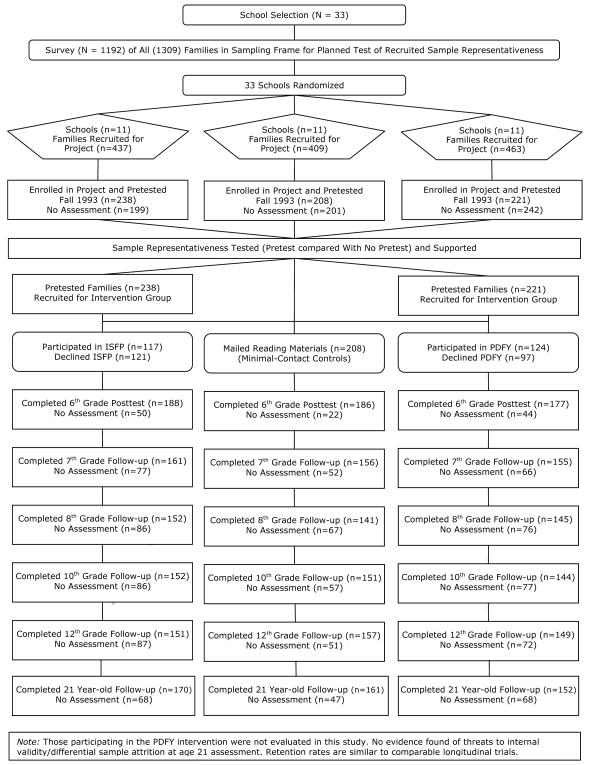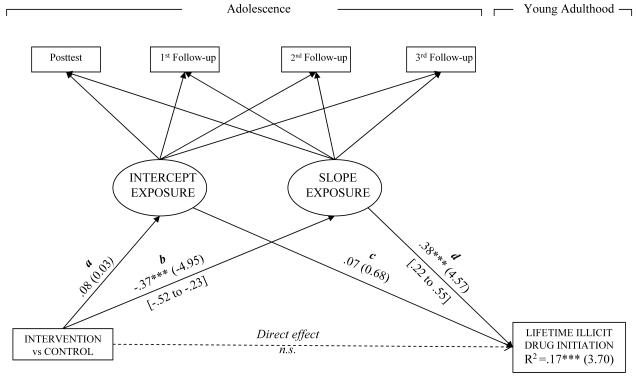Abstract
Purpose
An earlier randomized controlled study found that a universal, family-focused preventive intervention produced protective shield effects—reduced adolescent exposures to illicit substance opportunities—in grade 12. This study examines a follow-up assessment of the sample during young adulthood.
Methods
A RCT evaluated the Iowa Strengthening Families Program (ISFP) implemented in 22 rural schools (N=446 families) when participants were in sixth grade. Measures include adolescent substance use exposure and young adult lifetime illicit substance use (age 21; N=331). Growth curve modeling examined indirect intervention effects through growth factors of adolescent exposure.
Results
Findings confirm protective shield effects that mediate long-term reduction of use, β=−.14, P=.02, Relative Reduction Rate = 28.2%.
Conclusions
The benefits of decreasing substance use exposure during adolescence through universal interventions were supported, with positive effects extending into young adulthood.
Keywords: Preventive Intervention, Protective Shield, Illicit Substance Use, Young Adulthood
A “protective shield” is defined in the epidemiological literature as mechanisms shielding hosts from contact with pathogens, including environmental factors that protect against agents of a health problem.1 An earlier examination of preventive intervention outcomes applied this concept, operationally defined as the reduction of young adolescent exposures to substance use opportunities. That study evaluated ISFP, a universal preventive intervention for 6th graders and their families, designed to improve adolescent and parent skills that would likely reduce adolescent exposures to substance use opportunities. Intervention effects on illicit substance use at 12th grade were found, mediated by reduced substance exposures, with a 49% reduction of use.2 The current study evaluated whether the protective shield effect extended into young adulthood (age 21).
METHODS
University IRB approval and informed consent were obtained. Families of sixth graders in 22 Iowa schools were recruited in 1993; N=446 (49% of those eligible) completed pretesting. Analyses indicated the sample was representative.3 School selection was based on school lunch program eligibility (>15%) and community size (<8,500). Schools were randomly assigned to conditions. (Another intervention was included in the project, but because 12th grade illicit substance use was not significantly impacted by that intervention, we could not evaluate the protective shield effect in that earlier study, upon which the present one is based.)3 Household incomes averaged $40,600; 98% were White. Adolescents completed in-home interviews and questionnaires through 12th grade; at age 21 (N=331), they completed computer-assisted telephone interviews and questionnaires. Figure 1 summarizes project participation. Following pretesting, facilitators implemented ISFP in partnerships with public school districts and the University Extension System.3 ISFP addresses empirically-supported family risk and protective factors, such as parental nurturing, involvement, child management skills, and adolescent social skills. Observers reported high implementation fidelity, averaging 85% adherence to intervention content.3
Figure 1.
Participation summary.
Measures included illicit substance use exposure. Three items assessed general illicit substance use opportunities over the past year, asking: “During the past 12 months, did you ever have a chance to…” (1) “try marijuana?”, (2) “try other drugs, such as cocaine or crack?”, and (3) “sniff glue or inhalants to get high?” Summing dichotomous responses (No = 0, Yes = 1) and adding a value of 1 yielded scores between 1 and 4. Three additional items assessed opportunities specifically provided by peers, asking “How often do your friends try to get you to…” Item responses addressed the same three types of substances. Averaging item responses (Never = 1, Often = 4) yielded scores between 1 and 4. Scores on the two measures were averaged.
Because longitudinal assessments occurred at differing intervals, we determined the most appropriate outcome measure was dichotomous lifetime illicit substance use; its yes/no format avoids the imprecision of estimating amount or frequency of consumption. This measure was scored “0” for respondents until they answered “Yes” to any one of the 11 lifetime illicit substance use items (e.g., marijuana, inhalants, methamphetamine, cocaine, ecstasy, non-medical prescription drug use), after which it was scored as “1.”
Statistical modeling procedures replicated those reported in detail earlier.2,4 The growth of illicit substance use exposure was modeled as linear across the post-intervention period thought to be most critical—through 10th grade—based on means across time. The model controlled for pre-intervention exposure. The intercept was set at posttest. The slope value was the estimated rate of linear increase in exposure (see Figure 2). The intervention (vs. control) effect on exposure was estimated by specifying direct effects on both the intercept (path a) and slope (path b). In turn, the model included direct effects of the growth factors on illicit substance use (paths c and d) and also evaluated the intervention direct effect. Analyses were conducted in Mplus 5.2,5 using full-information maximum likelihood estimation to address missing data.
Figure 2.
Growth curve model.
RESULTS
Results are presented in Figure 2. Two compound paths assessed mediation of ISFP’s influence on illicit substance use through protective shield effects: (1) exposure immediately post-intervention (path ac); and (2) rates of increase in exposures across adolescence (path bd). Mediation of ISFP effects via reduction in exposures immediately post-intervention was not found (β=.01, P=n.s.). As expected, results supported an indirect effect of ISFP on young adult lifetime illicit substance use via reduction in the rate of increase of illicit substance use exposure across adolescence (β=−.14, P<.001; see Figure 2 for CIs and total ISFP indirect effects). Direct effects were not found. The model-based estimate of the percentage of ISFP participants who initiated illicit substance use at age 21 was 27.5%, and the corresponding percentage in the control group was 38.3%. The relative reduction rate (RRR—the difference between the control and intervention rates, expressed as a percentage of the control rate) was 28.2% (i.e., [38.3% - 27.5%]/38.3%).
DISCUSSION
Results support the idea that ISFP reduced illicit substance use into young adulthood by providing adolescents with a protective shield critical to preventing later illicit substance use. Relevant etiological research2,4,6-8 demonstrates how youth behaviors (e.g., participation in supervised, structured, prosocial activities) discourage substance use. The ISFP was designed to improve prosocial child behaviors, plus enhance parenting behaviors (e.g., parental monitoring) and foster positive parent-child involvement—factors that also can decrease substance use opportunities. Specifically, previous research has demonstrated ISFP effects on parenting and adolescent skills expected to limit substance use exposure. 3,6
A unique contribution of this research is the demonstrated effect of ISFP through age 21, a developmental period when most young adults no longer live with their parents. The current findings—especially considered in conjunction with other published intervention outcomes during young adulthood—contribute to an emerging literature on long-term effects of universal preventive interventions that illustrate the duration and size of effects.4 It does so by showing how intervention effects during the adolescence can positively impact young adulthood, when the highest levels of substance misuse can be observed. Nonetheless, the generalizability of results to non-rural and more ethnically diverse populations remains to be examined.
Findings also support the public health benefits of scaling up family-focused interventions. If the RRR results were to replicate, for every 100 young adults (age 21) initiating illicit substance use in communities not offering an intervention, there could be as few as 72 initiating in intervention communities. Scaling up the delivery of universal preventive interventions is critically important if these positive results are to produce wide-scale public health benefits.9 The present study was one in a series of projects informing the development and testing of effective community-based intervention delivery models that capitalize on the University Cooperative Extension System’s success in spreading program innovations.10
Acknowledgements
The authors wish to thank the study participants, our data collection unit, University Extension in the participating counties, and the University Extension personnel who implemented the program and conducted the fidelity observations.
Funding/Support: Work on this paper was supported by research grants DA 07029 from the National Institute on Drug Abuse, by grant MH 49217-01A1 from the National Institute of Mental Health, and by grant AA 014702-13 from the National Institute on Alcohol Abuse and Alcoholism.
Footnotes
Publisher's Disclaimer: This is a PDF file of an unedited manuscript that has been accepted for publication. As a service to our customers we are providing this early version of the manuscript. The manuscript will undergo copyediting, typesetting, and review of the resulting proof before it is published in its final citable form. Please note that during the production process errors may be discovered which could affect the content, and all legal disclaimers that apply to the journal pertain.
Conflict of Interest: There is no conflict of interest to report for any of the authors.
Contributor Information
Richard L. Spoth, Partnerships in Prevention Science Institute, Iowa State University, Ames, Iowa.
Linda S. Trudeau, Partnerships in Prevention Science Institute, Iowa State University, Ames, Iowa.
Max E. Guyll, Department of Psychology, Iowa State University, Ames, Iowa.
Chungyeol Shin, Partnerships in Prevention Science Institute, Iowa State University, Ames, Iowa.
References
- 1.Chen CY, Dormitzer CM, Gutiérrez U, Vittetoe K, González GB, Anthony JC. The adolescent behavioral repertoire as a context for drug exposure: Behavioral autarcesis at play. Addict. 2004;99:897–906. doi: 10.1111/j.1360-0443.2004.00774.x. doi:10.1111/j.1360-0443.2004.00774.x. [DOI] [PubMed] [Google Scholar]
- 2.Spoth R, Guyll M, Shin C. Universal intervention as a protective shield against exposure to substance use: Long-term outcomes and public health significance. Am J Public Health. 2009;99(11):2026–2033. doi: 10.2105/AJPH.2007.133298. doi:10.2105/AJPH.2007.133298. [DOI] [PMC free article] [PubMed] [Google Scholar]
- 3.Spoth R, Redmond C. Project Family prevention trials based in community-university partnerships: Toward scaled-up preventive interventions. Prev Sci. 2002;3:203–221. doi: 10.1023/a:1019946617140. doi:10.1023/A:1019946617140. [DOI] [PubMed] [Google Scholar]
- 4.Spoth R, Trudeau L, Guyll M, Shin C, Redmond C. Universal Intervention Effects on Substance Use Among Young Adults Mediated by Delayed Adolescent Substance Initiation. Journal of Consulting & Clinical Psychology. 2009;77(4):620–632. doi: 10.1037/a0016029. [DOI] [PMC free article] [PubMed] [Google Scholar]
- 5.Muthén LK, Muthén BO. Mplus User’s Guide. Fifth edition Muthén and Muthén; Los Angeles: 1998-2007. [Google Scholar]
- 6.Spoth R, Redmond C, Shin C. Direct and indirect latent-variable parenting outcomes of two universal family-focused preventive interventions: Extending a public health oriented research base. J Consult Clin Psychol. 1998;66:385–399. doi: 10.1037//0022-006x.66.2.385. PMID: 9583342. [DOI] [PubMed] [Google Scholar]
- 7.Benjet C, Borges G, Medina-Mora ME, Blanco J, Zambrana J, Orozco R, Fleiz C, Rojas E. Drug use opportunities and the transition to drug use among adolescents from the Mexico City Metropolitan Area. Drug Alcohol Depend. 2007;90:128–34. doi: 10.1016/j.drugalcdep.2007.02.018. [DOI] [PubMed] [Google Scholar]
- 8.Reboussin BA, Hubbard S, Ialongo NS. Marijuana use patterns among African-American middle-school students: A longitudinal latent class regression analysis. Drug Alcohol Depend. 2007;90(1):12–24. doi: 10.1016/j.drugalcdep.2007.02.006. [DOI] [PMC free article] [PubMed] [Google Scholar]
- 9.Spoth R. Translating family-focused prevention science into effective practice. Toward a translational impact paradigm. Curr Dir Psych Sci. 2008;17(6):415–42. doi: 10.1111/j.1467-8721.2008.00617.x. doi:10.1111/j.14678721.2008.00617.x. [DOI] [PMC free article] [PubMed] [Google Scholar]
- 10.Spoth R, Greenberg MT, Bierman K, Redmond C. PROSPER community-university partnerships model for public education systems: Capacity-building for evidence-based, competence-building prevention [Invited article for Special issue] Prev Sci. 2004;5:31–39. doi: 10.1023/b:prev.0000013979.52796.8b. doi:10.1023/B:PREV.0000013979.52796.8b. [DOI] [PubMed] [Google Scholar]




